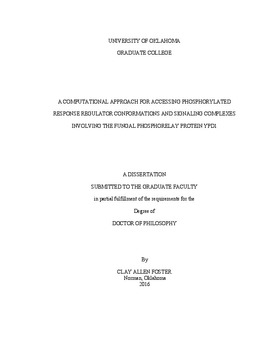| dc.contributor.advisor | West, Ann | |
| dc.contributor.author | Foster, Clay | |
| dc.date.accessioned | 2016-08-19T15:20:51Z | |
| dc.date.available | 2016-08-19T15:20:51Z | |
| dc.date.issued | 2016-08 | |
| dc.identifier.uri | https://hdl.handle.net/11244/44926 | |
| dc.description.abstract | Two-component signaling is the primary means by which bacteria, archaea and certain
eukaryotes sense and respond to their environments. Signal transfer proceeds through
sequential His-to-Asp phosphorylation of upstream histidine kinases and downstream
response regulators. These systems share highly modular designs and have been
incorporated into a myriad of cellular processes. The highly labile chemical natures of
phosphoaspartate and phosphohistidine lead to relatively short experimental life-times,
making study of the modified signaling proteins challenging. The focus of this research
was to develop computational and experimental approaches for characterizing
phosphorylated two-component signaling proteins. Following an introductory chapter,
the first experimental section presents a computational technique for simulating the
activation of individual response regulator proteins. This is accomplished using known
experimental data on conserved active site chemistry to define a common set of
restraints to drive each simulation. The protocol was verified on five genetically diverse
response regulators with known experimental structures. The second section applies this
principle to signaling complexes to study the effects of phosphorylation on protein-
protein interactions within the Saccharomyces cerevisiae osmoregulatory signaling
system. The third section describes the experimental characterization of a specific
signaling complex from Saccharomyces cerevisiae between the response regulator Ssk1
and a point mutant (G68Q) of the histidine phosphotransfer protein Ypd1 using X-ray
crystallography. This mutation occurs near the active site of both proteins and appears
to interfere with phosphotransfer. Further in silico studies were performed to observe
the role of G68 in catalysis of phosphotransfer. | en_US |
| dc.language | en_US | en_US |
| dc.subject | Cellular Signal Transduction | en_US |
| dc.subject | Phosphotransfer | en_US |
| dc.subject | Two-component Signaling | en_US |
| dc.subject | Molecular Dynamics | en_US |
| dc.title | A COMPUTATIONAL APPROACH FOR ACCESSING PHOSPHORYLATED RESPONSE REGULATOR CONFORMATIONS AND SIGNALING COMPLEXES INVOLVING THE FUNGAL PHOSPHORELAY PROTEIN YPD1 | en_US |
| dc.contributor.committeeMember | Cichewicz, Robert | |
| dc.contributor.committeeMember | Zgurskaya, Elena | |
| dc.contributor.committeeMember | Berkowitz, Ari | |
| dc.contributor.committeeMember | Dunn, Anne | |
| dc.date.manuscript | 2016-08 | |
| dc.thesis.degree | Ph.D. | en_US |
| ou.group | College of Arts and Sciences::Department of Chemistry and Biochemistry | en_US |
| shareok.nativefileaccess | restricted | en_US |
